Tiny House Landscaping
Have you given any thought to the landscaping around your tiny house? The structure itself demands so much of us that once the building is in place, we sometimes find ourselves exhausted before we’ve finished our masterpiece. Landscaping can be done in manageable stages, and gives us the opportunity to create a place of color, beauty, shade, and peace. More than a designing a private sanctuary, landscaping can be planned to incorporate other practical benefits as well.
Tiny house landscaping can be used to help conserve energy by creating shade, conserve heat by deflecting wind, create privacy, conserve moisture, and deaden sound.
This seasonal RV park resident above had a multitude of flowers, all in pots, so she could take it down each fall when she migrated to warmer climes. It was beautiful and created privacy.
Create More Living Space
With inside living space at a premium in a tiny house, expanding to the out-of-doors is an inexpensive way to get more living space.
Creating an outdoor kitchen removes the heat and moisture of cooking from inside the dwelling. An outdoor kitchen could be as basic as a lawn chair and a BBQ grill. Adding better seating and an Easy-up for shade makes the area even more useful.
Kids and pets need a safe and fun place to play! A fenced yard deters intruders, both human and otherwise.
See our page on Watching Movies Outside a Night for another fun activity.
Delineation of Areas
Most people like well-defined areas like a garden path, the border between the garden and the yard. I used pavers, landscape timbers and pea gravel to make an inexpensive path and a patio. The wood walkway was constructed from scraps left over from the deck.
Most items came from The Home Depot.
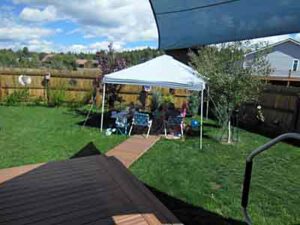
Making mistakes
When we bought our house in 2018, our yard consisted of dirt and ants. That’s it. No grass, deck, fence, trees, or plants; just dirt and ants. We had to work fast so it didn’t just blow away with the first big breeze. We also live on the edge of the desert, so growing grass takes serious time and effort. Starting with the front yard we covered it completely with weed control fabric and a truckload of wood chips. We prided ourselves for being water wise-and eco-friendly. Sadly, the wind we knew was coming blew the wood chips into the neighboring property.
The next year, wild grasses from the lot next door grew up through the weed guard fabric. It looked good for the first year, but deteriorated as the wood chips faded and migrated next door, and the weeds wove a stranglehold through the fabric. Raking up the remaining chips and tearing the fabric from the clutches of native grasses about did us in. Last year I planted grass, and continually work on it in the warmer months. It’s coming in nicely.
Rocks are a better landscaping choice in windy areas. Again, if you’re considering this, remember you’ll have to underlay a weed barrier, and that does deteriorate over time.
Snow dumps
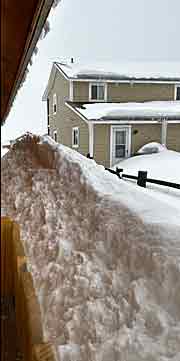
Our side yards are only eight feet wide. That’s just enough room for our metal roof to shed the 160-200″ of snow we get every winter. Needless to say, we can’t plant anything there. However, it still needs to be landscaped because we do enjoy summer for a few weeks every year, and we want it to look nice.
We covered the side yards with heavy plastic sheeting then added a layer of 2″ river rocks edged by landscape timbers. This works well to store the snow during the winter and drain the water away from the foundation come spring.
This is a photo of our side yard showing the snow berm from the roof. It’s higher than the 6′ fence.
We spent a lot of money for a sturdy Trex deck and a cedar privacy fence and don’t regret it. We now have a tiny summer sanctuary as seen in the picture above.
Choosing the Right Trees and Plants for Tiny House Landscaping
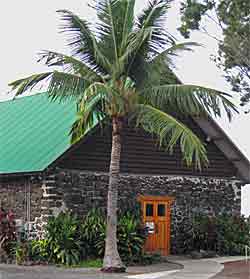
I dearly love palm trees but they won’t grow in the mountains of Colorado.
The trees you select for your tiny house landscaping will depend on many variables.
Where you live will strongly dictate the choices you’ll have. A local nursery will be a good guide just by seeing what they offer for sale in your area. Another consideration will be using the proper fertilizer and the right amount of water.
What do you need the trees to do?
Do you want your trees to offer shade? A small “ornamental” could be used to shade a single window, while a large tree like a cottonwood could shade an entire yard.
In one yard we planted spruce and pine trees. They provided shade during the summer, a windbreak year round, and softened the sound of a nearby highway. Plus, we never had to rake leaves. On the downside, our budget only allowed us to by tiny saplings that took more than a decade to grow to any appreciable size. We sold that house after 14 years. The new owner is enjoying the benefit of the mature pine forest around the house.
I like flowering trees, which typically means fruit. In Michigan we had apple and cherry. Apple trees do grow around here, but any fruit tree will often attract bears in the fall. Deer like eating them too. I planted an apple and pear tree in the front yard, but will need to keep them fenced for several years, as well as collecting any fruit in late summer before the bears go into hyperphagia (fattening up for the winter hibernation.)
Plants attract bugs
Most landscaping photos show beautiful foliage surrounding (and up against) the home. It’s pretty, but attracts bugs. In our first house we noticed an increase of spider, ants, and insects creeping indoors when the weather turned cold. Now we keep the plants away from the foundation.
Bugs attract birds. Many birds feast on bugs and will find your yard inviting. Be cautious when using pesticides on the bugs because you could end up killing the birds as well.
Good landscaping is a joy to behold. I made a collection of my favorite landscaping ideas on Pinterest.
Avoid Poisonous Plants

Oleanders are very popular in the desert Southwest, because they need almost no water and bloom year round. However, they are quite toxic! Nevada planted them all over the Lake Mead campground only to find that campers who used the dead limbs to cook with became deathly ill. Especially if you have children or animals, make sure the plants you select are safe.
Xeriscaping
Xeriscaping is the art of landscaping, or gardening, that reduces or eliminates the need for irrigation. This is where a drip watering system really shine, delivering water just to the plants.
See my board on Pinterest for beautiful examples of xeriscaping.
Using Natural Materials
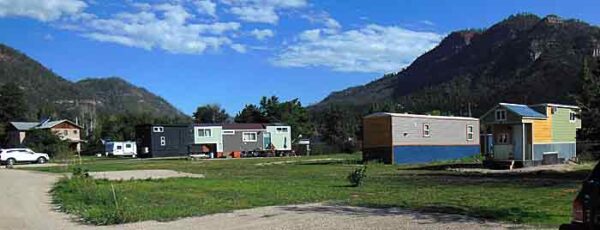
This new tiny house village in Durango, Colorado is a blank slate. Money is always tight, but in our area, aspen trees are cheap. Walmart, and even the supermarket, have these trees for sale.
It may take years for small trees and shrubs to grow, but get them planted. You’ll be surprised how fast those years go by.
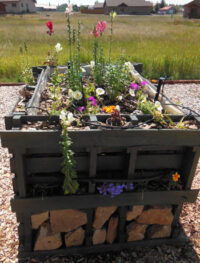
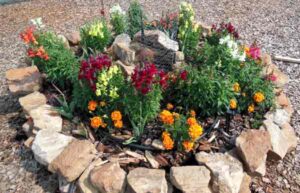 Using Local Materials
Using Local Materials
First I tried making a planter out of used pallets. It did not look as nice as the Pinterest photo. See what Pinterest said it was supposed to look like on this page.
Then I used local rocks and flowers that do well in my climate. What do you think? Better?
With my pallet experiment I did learn about drip watering systems and what flowers would work. There are tulips, daffodils, and crocus bulbs for spring color, and snapdragons for the rest of the summer.
See what grows in your neighbors’ yards and the countryside around you.
We have hungry deer that eat everything, so gardens must be well fenced. They love tulip bulbs. It turns out, however, they don’t like snapdragons or marigolds.
Ditch the Gas Powered Lawnmower
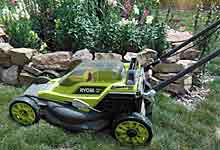
At our previous house I had a Toro, self-propelled, gas lawnmower. That’s what it took to do that huge yard. In our current home we have a postage stamp sized yard. The old lawnmower was just to big and unwieldy. I sold it a bought a light weight Ryobi cordless battery powered mower. At first it seemed like using an easy-bake oven compared to a real mower. I got used to it and found that it was way more maneuverable and took the place of my weed trimmer in a lot of cases.
Battery powered lawnmowers are more Eco-friendly than gas powered mowers. RYOBI cordless garden tools provide a powerful, convenient solution, eliminating the need for gas lawn and garden equipment.
Raised Garden Beds

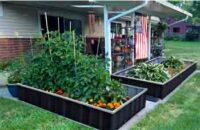
When you fill a raised garden bed with bags of soil and compost, you aren’t limited by the natural soil in your yard.
Also, with a raised garden bed you won’t need to bend over so far to tend it. Weeds pull out more easily and small pests like bunnies can’t get in. Raised garden beds can be made of rot resistant wood, galvanized farm tanks, even old bathtubs.
In this photo the off-grid tiny home owner uses old bathtubs, reusing his gray water for an aquaponics system. For more information on aquaponics and permaculture see the details on this page.
I plant perennials that come back year after year. Columbine are natives that not only regrow each spring, but also spread seeds.
Gardening for sustenance is hard work
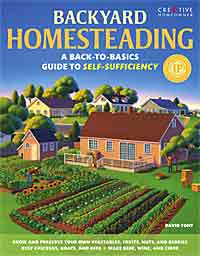
As a young guy I tried growing food several times, but at this late date, my aching back laughs at the very idea. “I’m fine with City Market being less than I mile away,” I smugly thought. Then came the pandemic and supply chain interruptions. Many staples at the grocery store were in short supply, and prices soared.
While it’s too late for me, you can still make this happen! I’ve very impressed with the Backyard Homesteading series of books. They promise to “turn your yard—no matter how small it may be—into a productive area that provides homegrown food, including fruits, vegetables, honey, eggs, milk, and meat!”
Find more books like this on The Best Off Grid and Wilderness Living Books page of this website.
Plants Need Water and Nutrients
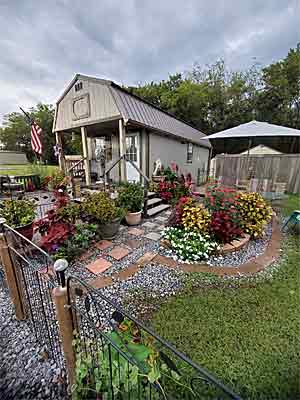
In this arid Colorado climate I can’t water the plants and trees enough. The native trees like aspens are fine, but the ornamental tree leaves are curled. My water bill in July was $178.00! I’m seriously thinking about a rain water catchment system.
Another good solution would be artificial turf. My sister uses that in Dallas. No need to water, but you might want to vacuum it from time to time.
You might have the opposite problem. Too much rain. Plants can drown. Most, unless they’re swamp plants, need oxygen around their roots or they will rot and die. Good drainage is a must.
I’m finding that forsythia, snapdragons, and roses grow great in hot sunny climates as long as they get enough water. Iris are also hard to kill. Siberian Iris grows well in damp areas. Ligularia and Cardinal Flower also do well in wet areas.
I also noticed that areas of the yard shaded by trees are cooler and need less watering.
Here’s Scott Bienvenu’s tiny house landscaping in Saint Martinville, Louisiana. It’s a shed conversion with inexpensive but beautiful landscaping. Click on image to see his FaceBook post.
To See More Photos of Tiny House Landscaping Visit These Pages
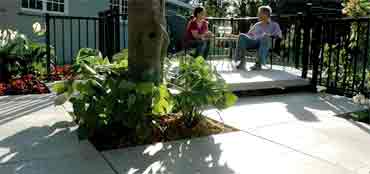
This snap together patio kit makes for quick and easy results. Professional quality that anyone can do.
Extending Our Living Space Outdoors
Awnings for Tiny Homes worthwhile addition
Off-Grid Resources and Information


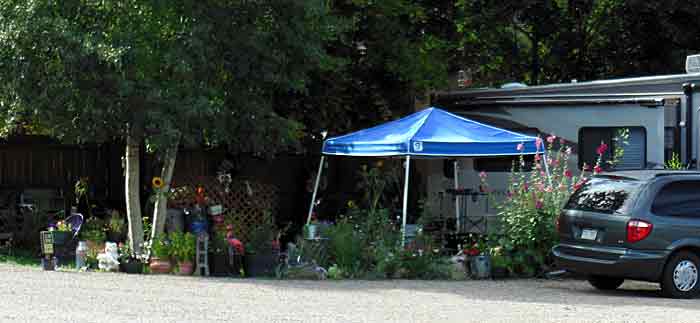
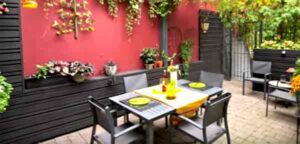
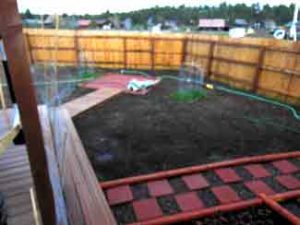

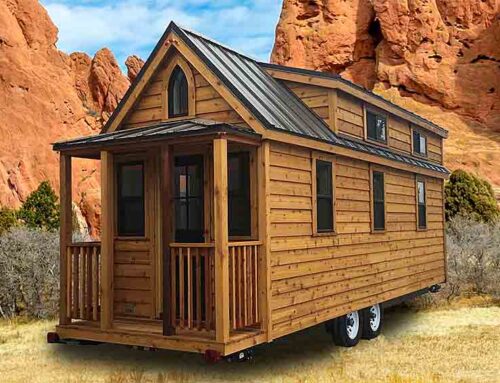
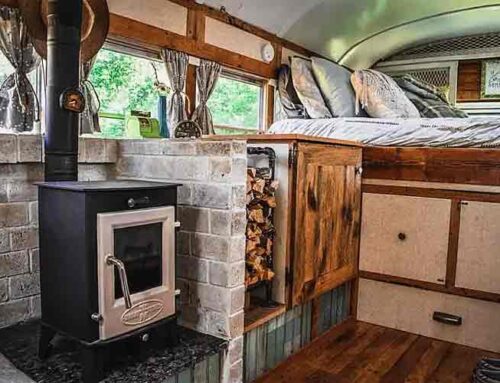
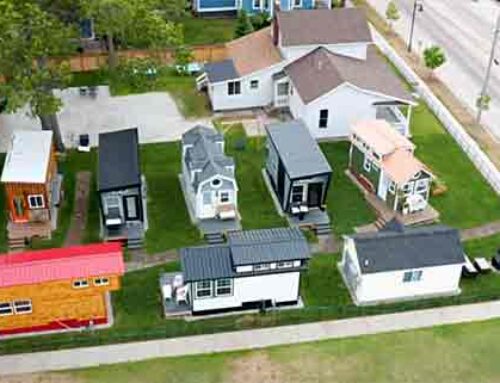
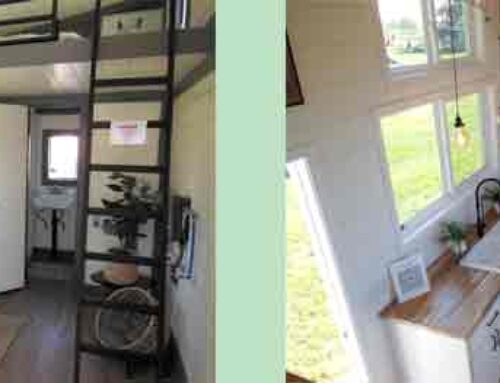
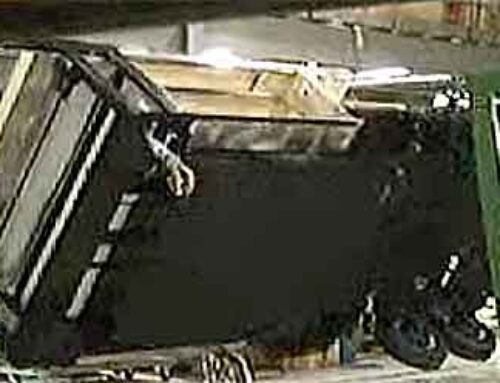
Leave A Comment